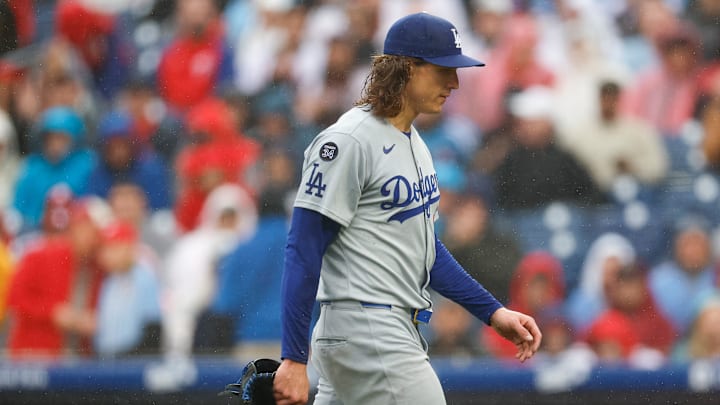I own several pieces of fine Wedgewood china. For those unfamiliar with Wedgewood, it is the kind of china you see displayed prominently in fancy armoires of upper-class families. It is a mark of status and savoir faire, the kind of ostentatious item that get passed down through generations.
It is beautiful to look at, the pedigree dating back more than two centuries to a fellow named Josiah. The one thing no cultured person would ever do with fine Wedgewood, however, is actually place food on it.
I have a developing sense that the Los Angeles Dodgers pitching staff is becoming baseball’s version of Wedgewood china.
The Dodgers have baseball's best rotation, but they don't use it
It certainly is expensive. This season, the Dodgers are paying seven men a total of $164.5 million to start games for them, and that figure does not include Shohei Ohtani.
It is also beautiful to look at. Blake Snell has two Cy Youngs, and Clayton Kershaw adds three more, Yoshinobu Yamamoto and Roki Sasaki were the most coveted Japanese imports of the past two seasons, and we haven’t even factored in 2024 All-Star Tyler Glasnow.
Collectively, the staff is a major part of the reason why the Dodgers were an almost unanimous choice as World Series favorites this season.
Yet, the Dodgers have adopted a Wedgewood-like “look but don’t touch” approach to the actual use of that elite staff this season.
It would be one thing if Los Angeles was running away with the NL West in the fashion that had been expected. However, after opening with eight straight victories, the Dodgers are 3-6 in their last nine games, having lost series to the Phillies, Nationals and Cubs, the latter at home this past weekend.
They woke up the morning of April 14 in third place in their division with just a game and a half separating them from a non-playoff spot.
The attitude of Dodger fans, adapted from Mad Magazine’s Alfred E. Neuman, is “what, me worry?”. From the L.A. perspective, the entire regular season is of no greater purpose than as a warmup for October. And it may work out that way.
In the interim, however, the Dodgers are minimizing the use of what is considered their best asset. Fifteen games into the season, LA starters are averaging the merest fraction above four innings of work per game, only four times having thrown a pitch in the sixth inning.
Two weeks into April, Dodger starters have on average faced just 48.5 opposing batters, the second smallest workload of any National League team, ahead of only the Brewers. The league average is about 64. Only Yamamoto (eighth) and Sasaki (30th) are in the league’s top 50 for pitches thrown, and thanks to their Tokyo Series appearances, they have both made more starts than other pitcher. For a serious contender, that’s Wedgewood-level ambivalence.
It also translates to extended use of the least reliable part of any team, the bullpen. That extended use is beginning to show. The table below compares the Dodgers with their three major NL West competitors — the Padres, Giants and Diamondbacks — for average innings pitched by starters, average number of relievers used power game, and relief runs allowed per game.
Team | Avg. stater IPs | Avg. relievers used | Avg. relief runs |
|---|---|---|---|
Dodgers | 4.3 | 3.9 | 2.2 |
Diamondbacks | 5.2 | 2.7 | 1.3 |
Padres | 5.1 | 3.5 | 0.7 |
Giants | 5.1 | 3.4 | 0.7 |
The data should be instructive. Despite having one of the most lauded rotations in the game, the Dodgers have actually used it a full inning per game less than any of their main divisional rivals.
Naturally, that means they have opened the bullpen door more frequently than their rivals, and they have done so at substantially less efficiency. Partly because they are carrying more of the load, Dodger relievers are allowing a full run more per game than any of their rivals, and three times as many as the lighter-used Padres or Giants bullpens.
Granted, a lot of those relief runs crossed home plate in one splurge by the Cubs this past weekend in a 16-0 drubbing. But, even eliminating that game from consideration, the Dodger 'pen has still allowed more runs per game than their peers on the Diamondbacks, Giants or Padres. The Dodger bullpen has been scored on in 11 games, three more than any of the NL West rivals.
There’s a lesson to be learned here, although the Dodgers appear unwilling to learn it. Unlike expensive Wedgewood china, even highly paid rotations are designed to be used rather than merely ostentatiously displayed.
